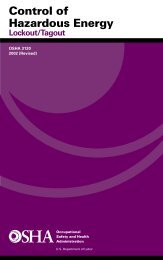Toxic Chemical Release Inventory Reporting Forms and Instructions
Toxic Chemical Release Inventory Reporting Forms and Instructions
Toxic Chemical Release Inventory Reporting Forms and Instructions
You also want an ePaper? Increase the reach of your titles
YUMPU automatically turns print PDFs into web optimized ePapers that Google loves.
<strong>Instructions</strong> for Completing Part II of EPA Form R<br />
1.3 Generic <strong>Chemical</strong> Name<br />
Complete Section 1.3 only if you are claiming the specific<br />
EPCRA section 313 chemical identity of the EPCRA section<br />
313 chemical as a trade secret <strong>and</strong> have marked the trade secret<br />
block in Part I, Section 2.1 on page 1 of Form R. Enter a<br />
generic chemical name that is descriptive of the chemical<br />
structure. You should limit the generic name to seventy<br />
characters (e.g., numbers, letters, spaces, punctuation) or less.<br />
Do not enter mixture names in Section 1.3; see Section 2<br />
below.<br />
In-house plant codes <strong>and</strong> other substitute names that are not<br />
structurally descriptive of the EPCRA section 313 chemical<br />
identity being withheld as a trade secret are not acceptable as a<br />
generic name. The generic name must appear on both sanitized<br />
<strong>and</strong> unsanitized Form Rs, <strong>and</strong> the name must be the same as<br />
that used on your substantiation forms.<br />
1.4 Distribution of Each Member of the Dioxin <strong>and</strong><br />
Dioxin-like Compounds Category<br />
Report a distribution of the chemicals included in the dioxin<br />
<strong>and</strong> dioxin-like compounds category. Such distribution shall<br />
either represent the distribution of the total quantity of dioxin<br />
<strong>and</strong> dioxin-like compounds released to all media from your<br />
facility; or your facility's one best media-specific distribution.<br />
When reporting dioxin <strong>and</strong> dioxin-like compounds, if there are<br />
any numbers in boxes 1-17, then every field must be filled in<br />
with either 0 or some number between 0.01 <strong>and</strong> 100.<br />
Distribution should be reported in percentages <strong>and</strong> the total<br />
should equal 100%. If you do not have speciation data<br />
available, you should indicate NA. If you are not reporting for<br />
dioxin <strong>and</strong> dioxin-like compounds, leave the entire section<br />
blank.<br />
You should not report the quantity of dioxin <strong>and</strong> dioxin-like<br />
compounds released or otherwise managed as waste in Section<br />
1.4. Quantities released or otherwise managed as waste must<br />
be reported in Sections 5, 6 <strong>and</strong> 8.<br />
There are 17 individual chemicals listed in the dioxin <strong>and</strong><br />
dioxin-like compounds category. Each of these chemicals are<br />
assigned a number from 1 to 17. These numbers correspond to<br />
the boxes in Section 1.4. The individual chemicals in the<br />
dioxin <strong>and</strong> dioxin-like compounds category <strong>and</strong> their number<br />
are in the matrix below:<br />
6 60851–34–5 2,3,4,6,7,8-Hexachlorodibenzofuran<br />
7 39227–28–6 1,2,3,4,7,8-Hexachlorodibenzo- p-dioxin<br />
8 57653–85–7 1,2,3,6,7,8-Hexachlorodibenzo- p-dioxin<br />
9 19408–74–3 1,2,3,7,8,9-Hexachlorodibenzo- p-dioxin<br />
10 35822–46–9 1,2,3,4,6,7,8-Heptachlorodibenzo- p-<br />
dioxin<br />
11 39001–02–0 1,2,3,4,6,7,8,9-Octachlorodibenzofuran<br />
12 03268–87–9 1,2,3,4,6,7,8,9-Octachlorodibenzo- p-<br />
dioxin<br />
13 57117–41–6 1,2,3,7,8-Pentachlorodibenzofuran<br />
14 57117–31–4 2,3,4,7,8-Pentachlorodibenzofuran<br />
15 40321–76–4 1,2,3,7,8-Pentachlorodibenzo- p-dioxin<br />
16 51207–31–9 2,3,7,8-Tetrachlorodibenzofuran<br />
17 01746–01–6 2,3,7,8-Tetrachlorodibenzo- p-dioxin<br />
Section 2. Mixture Component Identity<br />
Do not complete this section if you have completed Section 1 of<br />
Part II. Report the generic name provided to you by your<br />
supplier in this section if your supplier is claiming the chemical<br />
identity proprietary or trade secret. Do not answer “yes” in Part<br />
I, Section 2.1 on page 1 of the form if you complete this section.<br />
You do not need to supply trade secret substantiation forms for<br />
this EPCRA section 313 chemical because it is your supplier<br />
who is claiming the chemical identity a trade secret.<br />
Example 10: Mixture Containing Unidentified<br />
EPCRA Section 313 <strong>Chemical</strong><br />
Your facility uses 20,000 pounds of a solvent that your<br />
supplier has told you contains 80% “chlorinated aromatic,”<br />
their generic name for a non-PBT EPCRA section 313<br />
chemical subject to reporting under EPCRA section 313.<br />
You, therefore, have used 16,000 pounds of some EPCRA<br />
section 313 chemical <strong>and</strong> that exceeds the “otherwise use”<br />
threshold for a non-PBT chemical. You would file a Form<br />
R <strong>and</strong> enter the name “chlorinated aromatic” in the space<br />
provided in Part II, Section 2.<br />
1 67562–39–4 1,2,3,4,6,7,8-Heptachlorodibenzofuran<br />
2 55673–89–7 1,2,3,4,7,8,9-Heptachlorodibenzofuran<br />
3 70648–26–9 1,2,3,4,7,8-Hexachlorodibenzofuran<br />
2.1 Generic <strong>Chemical</strong> Name Provided by Supplier<br />
Enter the generic chemical name in this section only if the<br />
following three conditions apply:<br />
4 57117–44–9 1,2,3,6,7,8-Hexachlorodibenzofuran<br />
5 72918–21–9 1,2,3,7,8,9-Hexachlorodibenzofuran<br />
36 <strong>Toxic</strong>s <strong>Release</strong> <strong>Inventory</strong> <strong>Reporting</strong> <strong>Forms</strong> <strong>and</strong> <strong>Instructions</strong>
















